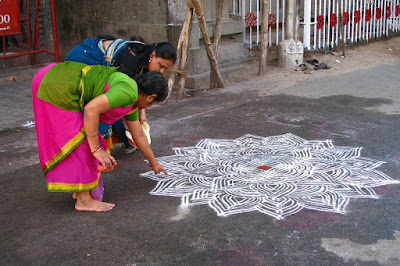In Indian Culture
Why do we do Rangoli? - Ushering in Auspiciousness
Traditionally done by woman on the forecourt of a house, courtyard, in the corner of a room, or before the image of a deity, Rangoli is a colourful pattern of lines, flowers and sacred motifs prevalent in Indian tradition. It is the Indian way of ushering in auspiciousness signifying an attitude of welcome to a house. It is a symbol of purifying and sanctifying the place of one's living, warding off all evil influences. Rangoli is also used to indicate that the lady of the house is ready to receive visitors.
Rangoli - Different Name in different provinces of India
Rangoli has different names in different provinces of India such as Chowkpurna or Purna in Uttar Pradesh, Alikhthap in Kumaon, Mandana in Rajasthan, Aripan in Bihar, Alpana in Bengal, Rangavallie in Maharashtra, Kolam in Tamil Nadu and Kerala, Muggu in Andhra Pradesh and Saathiya in Gujarat.
In many places it is a daily morning practice to draw a Rangoli, while in some it is mostly done on social gatherings, religious events or festivals. It is considered a part of the 'spirit of festivity' (utsav-dharmita), adding a sense of celebration and refinement to life.
How Rangoli patterns are created?
The patterns are created using the rice powder, coloured rice, dry flour, coloured sand, sindoor (vermilion), haldi (turmeric) or flower petals. Chalk powder, stone powder or chemical colours are modern variations of the material used for Rangoli.
Rangoli Designs
Rangoli designs are done using simple geometrical shapes, outlines of the form or symbol of a deity, or flower and petal shapes. An expression of bringing good luck, Rangoli designs reflect traditions folklore and practices that are unique to each area. Swastika, lotus flower, leaves, circles, steps of Lakshmi (the goddess of wealth and auspiciousness) and other similar auspicious motifs and symbols are used in Rangoli patterns. A Rangoli may be done using wet or dry colour powder.
Preparing a Rangoli is an ancient art practice rooted in religious lore and a spiritual world-view to life. Rangoli finds mention in traditions related to Ramayana, Mahabharata and lives of saints. It is a visible manifestation of man's desire to spiritualize the daily activities and sanctify the ambience in which he lives.
























